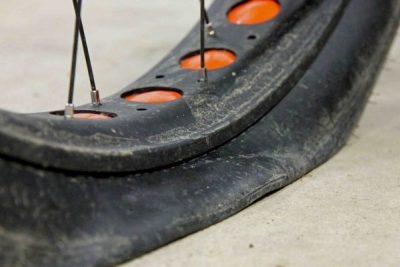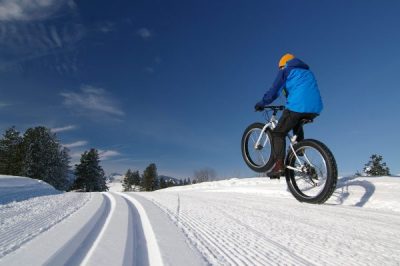Fat bike riders have numerous options when it comes to setting things up just right. It might be overwhelming for the new rider, but seasoned veterans are always looking for ways to improve their experience.
Tubeless tires have been around for a while, and the set up is available for any type of bike out there. Some people love going tubeless, while others might not feel completely sold. That thought process is the same for people using road bikes, mountain bikes, and fat bikes.
Since it feels impossible to give an answer that works for everyone, a better way to look at things is to list the pros and cons. Depending on how a person enjoys riding the fat bike, they can make a smart decision after that.
What are Tubeless Tires?
A tubeless tire is pretty much exactly what it sounds like. This is when a person opts to not have a tube in the tire, and instead go with a slightly different tire set up.
Tubeless tires have thicker sidewalls and a different bead to help keep tire pressure consistent. Rims and wheels have a different shape to help out tubeless setups as well.
Some people might be familiar with using tubeless tires on their cars and motorcycles. The trend is also very popular with some cyclists, since they are always attempting to cut as much weight as possible off of the bike. Is it the proper option to go with my fat bike? It depends on each individual.
What are the Main Advantages of Having Tubeless Tires?
Better Traction
Fat bikes are notorious for using very low tire pressure, so it makes sense for some to choose tubeless tires. This allows for an extremely low tire pressure, which helps with traction, comfort and more.
Just how low can a person go with their PSI? Some will drop to 4 or 5 PSI and still feel very confident while riding. The traction is better, the ride is smoother and fat bike enthusiasts just enjoy everything a bit more.
Improved Cornering
If there are a lot of twists and turns on the trails, a tubeless tire is very beneficial in cornering. Fat bike riders sometimes have trouble with this, especially if they are new to this type of bike in general.
There is a learning curve, but tubeless tires can reduce how long it takes to see a difference.
Cornering is hard to completely master for some people since the tires have such low pressure. Even though it is improved, don’t expect to jump on a fat bike and know how to do everything from the very beginning.
No Risk of Random Punctures Due to the Rim

Unless a person has experienced this type of puncture in the tire, they might not know exactly what this means. Sometimes referred to as a snakebite puncture, tires can develop a hole if the tube pinches against the rim.
This usually happens when the tire pressure in the tube is not as high as it should be. Everything else can be seemingly fine, and then this happens and frustrates riders for obvious reasons.
With a reduced risk of puncturing a hole, a person doesn’t have to worry about having an alternative option solution if something does happen. There are a few things worse than being stuck in the middle of nowhere without a functioning bike. Much like a snakebite, these holes can strike at any time.
Tubeless Tires are Lighter
Fat bikes are the heaviest options out there, which is frustrating for people who want to go fast. People are always trying to cut weight, especially if they race competitively. One way to do that is in the tires, as a tubeless option will be lighter.
Some people won’t think too much of that added weight, but every little bit matters. It all starts to add up once a person decides to tinker with their setup to see what works.
For casual riders, they don’t need to go this route for a minor difference. When a fat bike can sometimes weigh over 50 pounds, shedding a small amount of weight won’t matter that much. This is more so for the slimmer options.
Less Rolling Resistance

Since my bike tires are so wide and bulky, they do have a fair amount of rolling resistance. Tubeless tires cut down on that, as well as helping with faster speeds overall.
The changes are minimal just like the weight change, but anyone who pays attention to their tires will see a difference. Rolling resistance is one of the toughest adjustments people have to make when they go from a standard bike to a fat bike. By reducing it, it makes the learning curve a little smaller.
A Tube Works for a Quick Fix
One of the biggest worries for anyone who decides to start using a tubeless tire is that they might be in a situation where they have a hole they can’t fix. What is a person supposed to do when that happens? Well, a tube is something that can be added to a tubeless tire if needed. Sometimes, a hole can’t be properly sealed, and a tube will help with that.
Most people don’t see this as a permanent solution, but it’s a way to get home without having to call for assistance. It’s a great back up plan to have, especially for people who ride solo most of the time.
Increased Puncture Resistance
Without tubes, some might think that this could cause punctures a bit more frequently. The opposite is the case, since there are additional sealants in the tubes.
The walls are very strong and solid in a tubeless tire, so it takes a lot for a puncture to happen. Since fat bikes are hard to puncture in the first place, this is about as sturdy of a tire as one can hope for.
The Negatives of Going with Tubeless Tires
Tubeless Tires are Expensive
Since tubeless tires are not considered the standard, they are almost always going to be more expensive than traditional options. Some people think it is worth the investment, while others think it all evens out in the end.
Another thing to consider with the cost is that a person might need to purchase new tires and rims that are compatible with tubeless riding. Not everything is going to be set up completely for that out of the factory, so some adjustments might need to be made. That ultimately adds to the cost as well, which makes a subtle change a pretty big deal.
Different Maintenance Schedules
Tubeless tires might seem like they are perfect, but some maintenance is needed from time to time to keep things going strong. Most notably, the sealant in the tires needs replaced every couple of months. Otherwise, the tires become a bit too vulnerable, taking away some of the reasons why people love them in the first place.
A sealant isn’t particularly expensive, but it is more of keeping up with it that people forget about more often than not. No one should ever put themselves in a position where they don’t have sealant they can rely on. It is a quick way to ruin tubeless tires.
Professional Set Up is Sometimes Needed
Unless the person is very familiar with a fat bike, it’s recommended to have a professional set up tubeless tires in the beginning. There is simply too much difference between what people are usually using, and how it sets up in this way.
Even a professional will need about half an hour to change and set up a tubeless tire. The setup process should never feel rushed, or it could lead to tubeless tires not working the right way in the end.
There are occasions where tubeless tires can be installed without the need to make any changes to the bike itself. Ask before buying the bike if that is possible since many people are not sure whether they will go tubeless or not in the beginning.
Dealing With the Unknown
Most people who ride a bike understand how to change their own tire in a pinch. It might not go super smoothly, but it works. Since tubeless tires are much less common, not everyone will know what to do if there is an issue. There is no worse feeling in the world than riding a bike, and going down with a flat tire without knowing how to fix it.
Sure, there are cell phones these days that make it much easier to contact someone to help out, but it’s still a lot more of a challenge than taking care of things without assistance.
For added insurance, a lot of people will carry a spare tube with them if something goes wrong. While that might come in handy, some think that is defeating the purpose and advantage of
having a tubeless tire in the first place. It adds to the bulk a person must carry with them, just in a spare bag or pocket instead of inside the tire.
Common Questions
Still can’t decide? Here are a few common questions people have about tubeless tires, since not that many people are fully familiar with them before making the switch.
Just how low can tubeless tires be inflated?
Fat bike owners know that on average, there is no need to inflate the tires very high in the first place. With a tubeless option, there is a chance to drop to around 4-5 PSI for many people.
Keep in mind that heavier riders should probably bump up the PSI a bit, but those who are in good shape and don’t weigh much can get away with some very low pressure.
How common is it to find tubeless tires for fat bikes?
Since there are pros and cons to using this type of set up, not everyone is on board just yet. The benefits are there for those who are looking for a slight edge in performance. For people who casually ride once in a while, they likely won’t see a difference that will sway them enough to make the change.
Until tubeless tires become standard on bikes from the beginning, they will likely remain a niche option. It’s a unique way to change out the performance of the bike, but fat bikes are expensive enough already that not everyone is signing up.
Is there a way to convert standard tires into tubeless tires?
Just about every tire has the opportunity to convert into a tubeless option. Conversions are done either by local bike shops, those who know a lot about bikes or with the help of a conversion kit.
Keep in mind that unless a person is handy and already has all the tools, this is going to cost money. A lot of people end up spending $50-$100 to complete the process. It still ends up being cheaper than buying a good set of new fat bike tires though, so many don’t mind the investment.
Make sure it is done properly, or it could lead to complications in the end. That is why so many people will end up asking for professional assistance when doing the conversion.
Final Verdict: Standard or Tubeless Tires?
If a fat bike owner has the money, go tubeless. The overall performance of the bike is better, it saves a little bit of money every year (after the initial upfront cost), and there is less time wasted on maintenance.
There is a push going on currently for tubeless tires to be a bit more standard for the common fat bike straight out of the factory. The demand is growing each year, and it would not be shocking to see the percentage jump soon.
There will always be a demand for standard bikes and a tube, but the tubeless tire for a fat bike is the modern choice for many. It makes too much sense in a lot of ways for fat bike riders specifically.

